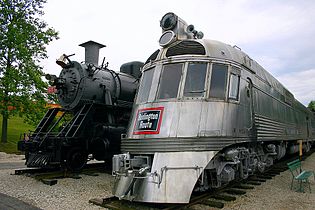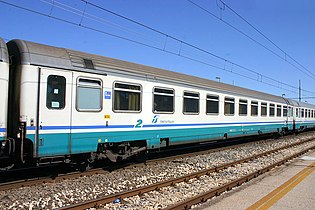| Part of a series on |
| Rail transport |
|---|
 |
|
|
| Infrastructure |
|
|
| Service and rolling stock |
|
| Urban rail transit |
|
|
| Miscellanea |
|
|

The term rolling stock in the rail transport industry refers to railway vehicles, including both powered and unpowered vehicles: for example, locomotives, freight and passenger cars (or coaches), and non-revenue cars. Passenger vehicles can be un-powered, or self-propelled, single or multiple units.
In North America, Australia and other countries, the term consist (/ˈkɒnsɪst/ KON-sist) is used to refer to the rolling stock in a train.
In the United States, the term rolling stock has been expanded from the older broadly defined "trains" to include wheeled vehicles used by businesses on roadways.
The word stock in the term is used in a sense of inventory. Rolling stock is considered to be a liquid asset, or close to it, since the value of the vehicle can be readily estimated and then shipped to the buyer without much cost or delay. The term contrasts with fixed stock (infrastructure), which is a collective term for the track, signals, stations, other buildings, electric wires, etc., necessary to operate a railway.
Gallery
- Rolling stock
-
 Steam and diesel locomotives
Steam and diesel locomotives
-
 Electric locomotive
Electric locomotive
-
 Diesel multiple unit (DMU)
Diesel multiple unit (DMU)
-
 Electric multiple unit (EMU)
Electric multiple unit (EMU)
-
 Railcar
Railcar
-
 Passenger car or coach
Passenger car or coach
-
 Hopper car, one of many types of revenue freight cars
Hopper car, one of many types of revenue freight cars
-
 Articulated well cars with intermodal containers
Articulated well cars with intermodal containers
-
 European covered goods wagons
European covered goods wagons
See also
References
- "Yaxham Light Railway rolling stock page". Archived from the original on 2015-09-20. Retrieved 2007-02-07.
- "Definition of "rolling stock" from the Oxford English Dictionary accessed 5 February 2007 (subscription service)". Archived from the original on 28 September 2020. Retrieved 5 February 2007.
- "Definition of "rolling stock" from the Concise Oxford Dictionary". Archived from the original on March 6, 2007.
- "Definition from the American Heritage Dictionary". Archived from the original on 2009-02-22.
- McAuliffe, Des (1999). "The Snowtown to Port Pirie line". Proceedings of the 1999 convention. Modelling the Railways of South Australia. Adelaide. Archived from the original on 2021-12-12. Retrieved 2021-09-10.
- "Rolling stock". The Free Dictionary. Farlex. Archived from the original on February 23, 2017. Retrieved January 27, 2017.
- Illinois Department of Revenue. "RUT-7: Rolling Stock Certification" (PDF). Archived from the original (PDF) on July 5, 2018. Retrieved January 27, 2017.
- "Michigan's Rolling Stock Exemption". TaxRates. Avalara. Archived from the original on February 2, 2017. Retrieved January 27, 2017.
- Finger, Matthias; Bert, Nadia; Kupfer, David, eds. (2014). "Rail infrastructure and rolling stock: investments, asset renewal and regulation" (PDF). European University Institute, Florence School of Regulation. pp. 8–9. Archived from the original (PDF) on 2017-02-02. Retrieved 2017-01-27.
- Wijnia, Y.; de Croon, J.; Liyanage, J.P. (2014). "36: Application of a Unified Reference Model Across Asset Types: Comparative Cases". In Lee, Jay; Ni, Jun; Sarangapani, Jagnathan; Mathew, Joseph (eds.). Engineering Asset Management 2011: Proceedings of the Sixth World Congress on Engineering Asset Management. London: Springer. pp. 416–417. ISBN 978-1-4471-4993-4. ISSN 2195-4356. LCCN 2013934026 – via Google Books.
External links
- [REDACTED] Media related to rail vehicles at Wikimedia Commons
- [REDACTED] The dictionary definition of rolling stock at Wiktionary
| Rail transport passenger equipment | |
|---|---|
| Head-end equipment | |
| Passenger-carrying coaches or cars | |
| Miscellaneous equipment | |
| Motorized | |
| Rail transport freight rolling stock | |
|---|---|
| Enclosed equipment | |
| Open equipment |
|
| Non-revenue equipment | |